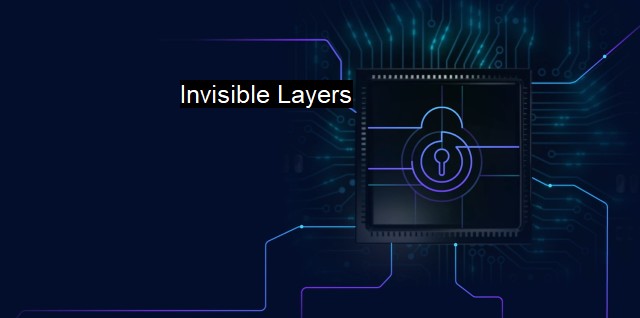What are Invisible Layers?
Invisible Layers: The Indispensable Security Mechanisms Employed by Antivirus and Cybersecurity Software to Protect Against Cyber Attacks
Invisible Layers is a term refers to the various layers of defense within cybersecurity and antivirus systems that provide a robust defense against threats. effective risk management involves implementing multiple protection measures to guard against different types of attacks. This comprehensive strategy is often called defense in depth which involves a series of defensive mechanisms layered over each other.One common misconception about cyber attacks is that they happen suddenly - a mysterious hacker types at lightning speed, bypasses the security system, and breaches the network. The reality is more complex and involves a series of steps, or what experts call an attack chain. To confront these intricate attempts, Invisible Layers are thereby adopted in cybersecurity.
Understanding the Invisible Layers requires a step-by-step approach. The outermost layers focus on preventing intrusion by external threats, while the intermediate layers help prevent the spread of malicious entities within the network, and the core layers offer a final line of defense, protecting the most valuable assets. An ideal Invisible Layers strategy does not just protect the system from attacks, but catches them early and minimizes their impact on the network’s overall security and productivity.
An application of the Invisible Layers lies in firewalls, the first line of defense against any potential cyber threats. Regular updates ensure these firewalls are prepared for the latest attack methods. Another layer is the Intrusion Detection or Prevention Systems (IDS/IPS) that monitor the network for malicious activities, offering crucial intelligence to respond to threats. Yet another critical layer is robust antivirus software. Each layer is tasked with protecting the network from different types of threats, providing full coverage and greatly enhancing a network's resilience to attacks.
Email and web filters mark another set of layers; by screening incoming and outgoing network traffic guided by certain rules, these filters become extremely effective in stopping unsolicited communications that might be disguised as phishing or other types of attacks.
Patches and other system updates function as yet another Invisible Layer, helping to fix security vulnerabilities and maintain system integrity. Similarly, regular audits and analysis of logs and network activities provide insights into any unusual happenings that might signal a potential security breach.
One important layer that's often neglected because it's not a tool or procedure but a factor of human behavior is training and education. Cybersecurity awareness among employees creates another crucial, internally-driven layer of defense that prevents human errors that can trigger security breaches.
The beauty of Invisible Layers lies in extent of the system's inherent strength and their redundancy. If one layer becomes compromised, others remain to protect the network's integrity. They also accommodate the reality of the continuously changing threat landscape, as upgrading any layer won't disrupt the overall system, providing durational system protection, and ensuring that the infrastructure remains secure while adapting to emerging trends in cybersecurity.
A substantial aspect worth noting about Invisible Layers is their proactive nature. Instead of reacting to attacks after they’ve occurred, the Invisible Layers work together to preemptively identify and mitigate threats. This approach significantly reduces the likelihood of successful attacks, and ensures faster recovery times if a breach does occur.
The Invisible Layers in cybersecurity aren't stones that sit around and hope for the best. They play an active role in ensuring that every loophole is carefully addressed to prevent cybersecurity threats. The Invisible Layers may not be visible to users, but they work behind the scenes to safeguard data and other digital assets. Leveraging all these layers collectively and strategically equates to a sturdy defense that accommodates the cyber world's dynamic nature and the constantly evolving threats it brings.

Invisible Layers FAQs
What are invisible layers in cybersecurity?
Invisible layers in cybersecurity refer to the layers of protection provided by an antivirus program that are not visible to the user. These layers are designed to prevent malware and other security threats from infecting the system.How do invisible layers contribute to virus protection?
Invisible layers contribute significantly to virus protection by providing a multi-layered defense mechanism. These layers monitor and analyze system activity, check for known malware patterns, and detect suspicious behavior to prevent malware from executing on the system.Can invisible layers alone provide complete virus protection?
No, invisible layers alone cannot provide complete virus protection. They are just a part of a comprehensive antivirus program. Other important factors include regular software updates, secure browsing practices, and user education on safe online behavior.Are there any downsides to using invisible layers in antivirus software?
The use of invisible layers does not have any significant downsides. However, it may slightly impact the performance of the system, as it requires a certain amount of resources to run in the background. However, this impact is usually negligible and should not be a cause for concern.| | A | | | B | | | C | | | D | | | E | | | F | | | G | | | H | | | I | | | J | | | K | | | L | | | M | |
| | N | | | O | | | P | | | Q | | | R | | | S | | | T | | | U | | | V | | | W | | | X | | | Y | | | Z | |
| | 1 | | | 2 | | | 3 | | | 4 | | | 7 | | | 8 | | |||||||